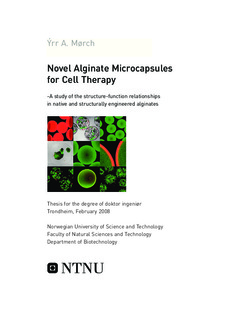| dc.description.abstract | Alginate microcapsules have the potential as immune barriers for cell transplantation where the alginate gel protects the transplant from the host immune system. Microencapsulation can thus provide a way to overcome the need for immunosuppressive drugs. The successful use of alginates as immobilization material has, however, been hampered by their mechanical instability and high porosity. To overcome this problem, a polycation layer has traditionally been added to the alginate gels. However, polycations are toxic to cells and provoke inflammatory reactions. Hence, the main goal of the present work was to improve the functionality of alginate gels in order to omit the use of polycations. Alginate gel properties were found to depend strongly on many factors such as the choice of alginate material, choice of gelling ion and method of preparation, all which can be manipulated to form alginate gel beads with enhanced functionality.
In particular, specific enzymes (C-5 epimerases) that modify the alginate chain were used to form novel alginate materials, some with extreme composition not found in nature. Gels of enzymatically engineered alginate were found to be more elastic and compact, less permeable, and extremely stable under physiological conditions, offering significant advantages over native alginates. Hence, by controlling alginate nanostructure in a highly specific way, we were able to manipulate the macroscopic properties.
One of the most striking features of epimerization was the effect seen upon increasing the amount of alternating sequences in the alginate chains using the specific epimerase AlgE4. On the basis of a detailed study on the resulting products of AlgE4 epimerized alginate we hypothesized the direct involvement of the alternating sequences in junction formation. The choice of gelling ions for alginate gel formation was also found to have significant effects on the final gel properties. Interestingly, the effect was highly dependent on the alginate material used. Application of alginates with extreme composition revealed that different block structures in the alginate bound the ions to different extent. Alginate beads with enhanced functionality could hence be formed using a proper combination of ions and alginate material. Finally, confocal laser scanning microscopy (CLSM) was established as a versatile and easy method to visualize the macroscopic character of alginate microcapsules such as the polymer distribution in capsules. Further, effect of different encapsulation procedures on the final capsule characteristics was revealed. | nb_NO |
